
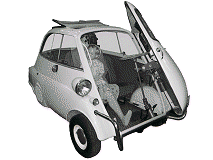

|
 |
|
|
Cars
and the Car Industry Motorcycles Scooters Road
Signs Licences Driving
Tests Road
Tax The
Highway Code Reg
Plate Numbers and Indicators
Haulage Lorries and Vans London Transport Buses London Underground Milk and Ice Cream Vans & Chimes Emergency Services Hovercraft Passenger Airlines and Aircraft Charter Airlines London Airports British Railways Cruise Lines, Liners and Ferries Military World Speed Records: Land Water Two Wheels Air Steam Trains Electric Trains Other Trains Transport Industry Events and Timeline - 1950 to 1969 Transport Videos and Links The Mini Moke Metrication TV / Radio Detector Vans Major Road Construction and Motorway Services |
 |
| Sixties Transport There were only 8,000 cars in the whole of Britain at the start of the 20th century. By the end of the century the car population had soared to 21 million. The main 'boom' in car ownership happened during the 1950s and 1960s. Car ownership in London quadrupled between 1950 and 1970 due to the rise in the standard of living and the reduction in car prices brought about by improved mass manufacture techniques. By the mid-1960s there were 1.5 million cars registered in London alone. The growth in car ownership also brought increasing traffic congestion but, in the 1960s, Central London's traffic problem was only considered to be significant during the morning and evening 'rush hours'. For those in London with no motorised transport there was always the ubiquitous red bus. The most famous of these, the double-decker Routemaster, was designed for London Transport in 1959 by Douglas Scott ( who also designed telephone booths in 1963 ) and was destined to become one of the icons of Sixties London. For paying passengers there were also the 'black cab' taxis and the London trolleybuses, the last of which ran on May 8th 1962. The first minicabs were launched in the capital by a company called Carline in Wimbledon on 6th March 1961. The London Underground system has, of course, been there forever but in 1962 London's first new tube line since before the War was authorised. It took five years to build the Victoria Line (between Walthamstow and Victoria). If you wanted to travel free you could get yourself a space-age folding bicycle - the Moulton. It was originally designed in 1958 by Alex Moulton but Raleigh, the major cycle manufacturer of the period, were not interested. Moulton continued to produce the machine and it became almost a fashion accessory in the built-up city areas by the mid-Sixties until Raleigh realised their error and took the company over in 1967. Raleigh also produced a moped - the Raleigh 'Wisp' - a bicycle with an engine of sorts. |
 Cars
and the British Car Industry Cars
and the British Car Industry |
 |
| The
importance of personal transport increased dramatically during the Sixties,
particularly the car. The industry saw a lot of post-war streamlining
and many of the independent companies of the 40s, 50s and early 60s had
been swallowed up by conglomerate groups by the end of the decade. The biggest major manufacturers of the decade, in Britain, were B.M.C. - The British Motor Corporation (Austin-Healey, Austin, Morris, Riley, MG, Wolseley, Vanden Plas), Rootes Group (Hillman, Humber, Singer, Sunbeam), Jaguar, Standard-Triumph, Ford, Rover / Land Rover, Vauxhall, Rolls-Royce / Bentley, Daimler and Aston Martin. Smaller independents such as Lotus and Jensen managed to survive as did most (but not all) of the producers of 'specialist' cars such as TVR, Reliant, Marcos, Ginetta, Gilbern, Morgan and Bond. One of the 'iconic' vehicle types, first appearing in the Fifties but its image inextricably linked with the Sixties was the 'bubble car' whose popularity in Britain first arose as a result of the mid-Fifties fuel crisis and the increasing demand for cheap personal motorised transport. Lighter frames and smaller engines meant far greater fuel economy than the post-war 'gas-guzzlers, albeit more limited in carrying capacity. The bulk of these were three-wheelers, which meant that they only attracted the same road taxes and licensing requirements as motorcycles. A large proportion were of German manufacture, notably by former military aircraft manufacturers Heinkel and Messerschmitt and BMW produced the most popular Italian-designed Isetta under licence, using the engine from one of their own motor bikes. BMW built 135,567 Isettas in Munich before production ceased in 1962. Isetta of Britain produced about 30,000 cars. An unusual feature of most bubble cars was the front entry door, a clever space-saving design unless you happened to park facing a wall in a model that had no reverse gear! In Britain, right-hand drive versions of the Heinkel bubble car were built under licence by the Trojan company and Isettas were also manufactured under licence being made as a three-wheeler, instead of the original two narrow rear wheels, to qualify it for motorcycle status. Britain also had its own home-grown lightweight products such as the Peel Trident, made in the Isle of Man. France manufactured large numbers of microvehicles as well, called 'voiturettes', but these were not actively marketed abroad. The Messerschmitt KR175 and KR200 models and the FMR (Fahrzeug- und Maschinenbau GmbH, Regensburg) Tg500 'Tiger' (only about 320 of these were made) sported aircraft cockpit-style bubble canopies, giving rise to the generic name 'bubble car', fully stylised by the later Isettas' streamlined 'bubble-like' appearance. |
|
 |
The most famous car of
the Sixties was, without doubt, the Mini. Designed by Alec
Issigonis, it was first seen on 26th August 1959 and was originally
named the Austin Seven or the Morris Mini Minor depending on whether
it was built at Longbridge or Cowley. Alec Issigonis became chief engineer
and technical director at BMC in 1961, was awarded the CBE in 1964 and
knighted in 1969. His
brief was to produce a metal box with four wheels, no more than 10 feet
long, to carry four adults in comfort along with their luggage. The
factory foreman, Albert Green, assembled the first Mini - registration
number 621 AOK - in just seven hours, in early 1959, at the Longbridge
factory in Birmingham! It was first seen by the
public at the Geneva Motor Show on 16th March 1961 and came in hard-top
or open-top versions at a price of around £2100, with a 3.8 litre
six cylinder 'S' type engine which developed 265 bhp allowing it to
go from 0 to 100 in about 16 seconds. The
last coloured E-type was a sable brown 1975 V12 5.3 litre convertible
commissioned by Jaguar founder Sir William Lyons. Only 50 more were
made after that, all of them in black.
|
|
Some
other 'classic' cars of the Sixties included, but were by no means limited
to: 1962 - Aston Martin
DB4 Vantage, Ford Zodiac III, Mark 1 Cortina, MG 'B', Opel Kadett, Triumph
Spitfire, Morris 1100, Ford Zephyr Mark III, Lotus Elan, 1963 - Ford Anglia,
Hillman Imp, Porsche 911, Vauxhall Viva, AC Cobra 289, TVR Griffith,
P6 2000, Austin 1100, Aston Martin DB5, Bristol 408, Triumph 2000, 1964 - Ford Mustang,
Austin 1800, Mini Moke, Bedford Beagle, Chevrolet
Chevelle, Fiat 850, Ferrari 275, Ford Corsair, Moskvitch 408, Nissan
Silvia, NSU Spider, 1965 - Reliant Scimitar
Coupe, Vauxhall FC Victor, Ford Zephyr Executive, Wolseley 1100, Aston
Martin DB6, MGB GT, Alfa Romeo GTA, Audi F103, Bristol 409, 1966 - MGC GT, Mark
II Mini, Jensen FF and Interceptor, Ford Cortina Mark II, Lotus Europa,
Hillman Hunter, Alfa Romeo Spider, Volvo 144, Audi 80, DAF 44, 1968 - Jaguar XJ6,
Ford Escort and Corsair, Reliant Scimitar GTE, Morgan Plus 8, AMC Javelin,
Audi 100, Volvo 164, Colliday Chariot, Bristol 410, Opel GT, 1969 - Austin Maxi,
New Style Ford Capri, Aston Martin DBS, Datsun 240Z, Autobianchi A112,
Bedford CF, Bristol 411, Chrysler Valiant, Dacia 1300, Morris Nomad,
|
|
|
Top 10 Best-Selling Cars
of 1969:
|
From a vehicle
ownership base of about 9.5 million in 1960, the British market had
increased to about 15 million cars by the end of the Sixties. Manufacturing
cost problems, not helped by the multitude of strike actions during
the decade, caused many of the manufacturers to merge, or disappear.
For instance: in September 1966 7,000 workers were laid off by BMC.
who announced plans for 11,000 redundancies.
|
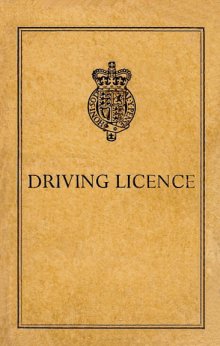
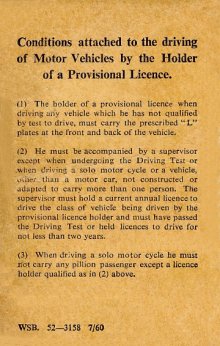
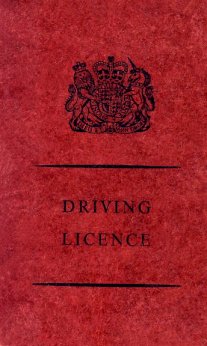



| On cars first registered before 1963 (or 1965 in some cases), the plates usually carried the three letters before the numbers (between 1 and 999 e.g. ABC 123), but some were reversed with the numbers preceding the letters. In the group of three letters, the second and third letter (BC) made up the 'area identifier' and indicated where the vehicle was first registered (area identifiers for vehicles registered from 1st September 2001 are different to those used with this system). Car Registration Identifiers |
| If the plate was reversed, e.g.
123 ABC, the second two letters (BC) were still the area identifier. The
first letter and numbers, in this example A__ 123, were the individual
element that gave the vehicle its unique identity. The numbers were issued
in sequence from 1 to 999. The letter (called the serial letter) was issued in sequence, usually when all possible numbers had been used up, so ABC1 would be followed by ABC2, up to ABC999, when the next issue would be BBC1. |
|
 Before the 1930s road signs were usually made of cast iron, which was gradually replaced by cast aluminium during the 1930s. Both these types of sign had raised lettering that made the fairly frequently-required repainting comparatively easy. The reflective 'Scotchlite' material sealed onto sheet aluminium started to appear during the Fifties, making the signs much more visible at night and doing away with the need for repainting. The major changes to the appearance of UK road signage, to make them more 'international' and better mirror common European practice was brought about in two main stages. The first was a necessary introduction of a completely different signage for the UK's new motorways, developed by the Anderson Committee in 1957. Although it was an addition to existing signage, it created a number of 'standards' that were developed further by the Worboys Committee of 1963 and which were mainly responsible for the changes to 'ordinary' road signage from 1964 that are still used today. The old signs were a mixture of graphics and text, unlike European signs that depended mainly on symbolism to get their message across. The new signs avoided the use of a separate 'information plate' and included relevant detail within the symbol itself e.g. the red 'warning' triangle now contained a graphic depicting the hazard. Unlike previous 'piecemeal' attempts at signage regulation, the Worboys Committee proposed a complete redesign of the entire system, resulting in a massive resignage project. Mandatory and prohibitive signage was the first to be changed, with warning and directional signage following over the next decade and very few pre-1964 signs survived more than about ten years. A third change was introduced by The Guildford Rules in the mid-1980s that stipulated features such as colour-coding to indicate different categories of road. Margaret Calvert, along with her colleague Jock Kinneir (neither of whom could drive), designed an entirely new signage system for the UK’s roads. Just out of the Chelsea School of Art (where Kinneir had been her tutor), the pair were asked to design signs for the first motorway in the UK. Sleek, modern and intended to enhance European commonality, they were colour-coded, distinctive and easy to read at speed (the 70mph limit not yet being imposed). When the government became concerned about the state of road signs in general, that contained a mixture of words, styles and fonts, the pair were asked to do the same for all national roads. The lettering and sizing were all tested – sometimes using airmen at a field in Oxfordshire as test subjects. The signs were put on a car and the airmen sat on a platform, saying when they could read the word on it as it drove towards them.The pair went on to design signs for everything from the NHS to British Rail. |
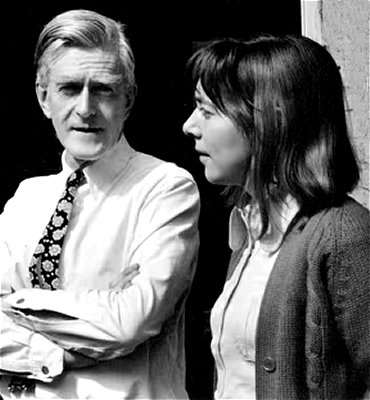
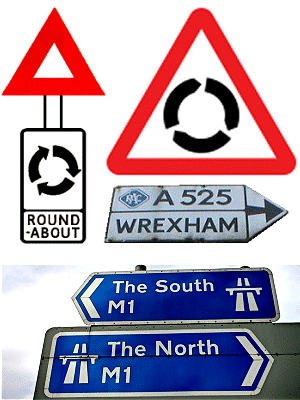 |
|
On two wheels,
the Sixties saw the Japanese motorcycle manufacturers coming to the
forefront, particularly Honda and Yamaha, with brand new machines and
technology, where just a few years previously they had been copying
British designs very closely. Although the British motorcycle industry
had been in decline since the late Fifties due to a combination of government
incompetence and bad management, British machines still ruled the superbike
end of the market for much of the decade but were being overtaken by
Japanese technology and designs by the end of the Sixties. Motorcycle
production of the leading nations in 1969 was:
|
|
1964: Competition TT special built for the U.S. market only, with bigger carbs, 11:1 compression and a Lucas ignition system 1966: Smaller fuel tank, 12 volt electrics and fairing lugs fitted for police use 1968: 30mm Amal concentric carbs, new front frame and swinging arm, tls front brake and compression increased to 9:1 1969: Triumph Trident introduced
a 3-cylinder machine. |
 |
1963: Twin carb A65 Rocket launched in the UK, called Thunderbolt Rocket in the USA. 1964: Twin carb A65L Lightning
introduced as competition to the Triumph Bonneville. 1965: The Thunderbolt, a single carb version of the Lightning, was introduced as a replacement for the A65 Star tourer. |
1962:
Norton Atlas launched in the U.S.A. 1964:
Norton Atlas launched in the U.K. in February 1968: First production
Commandos appear in April. After
the Commando 'Fastback' came the 'R' model which sported the later 'Roadster'
tank/seat, but was in most other respects still very much like the Fastback.
The Roadster in turn led to variations such as the 'S' and 'SS' models. |
Initially a nominal 750cc displacement (actually 745 cc) the Commando became an 850cc in 1973. |
 Scooters
Scooters



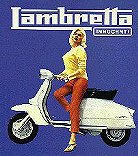 |
The
motorised Mod alternative to the motorcycle was the Italian-produced scooter
which had much smaller wheels and, generally, engines, although race-tuned
machines were surprisingly fast. The most popular and famous makes were
Lambretta and Vespa, the Italian 'wasp' earning the nickname of 'hair
dryer' due to the shape of its distinctive side panels which covered the
engine. The machines were a dream to customise, many sporting superbly
artistic paint jobs and invariably adorned with an excess of mirrors,
lights or other paraphernalia and were as much a fashion accessory or
art form as a mode of transport. Over 40 British scooter makes were made from post World War Two to the time the last scooter was made in Britain in the late 1960s. Raleigh Mopeds. Vespa is an Italian brand of scooter manufactured by Piaggio. By the mid-1950s, Vespas were being manufactured under licence in Germany, the United Kingdom, France, Belgium and Spain and, in the 1960s, production was also started in India, Brazil and Indonesia. By 1956, one million Vespas had been sold, becoming more than two million by 1960. By the 1960s the Vespa, originally conceived as a utility vehicle, had come to symbolise freedom and imagination, resulting in sales that reached 4 million by the end of the decade. There have been 138+ different versions of the Vespa since production began and, when Vespa celebrated its 50th anniversary in 1996, more than 15 million scooters had been sold worldwide, making it the most successful scooter manufacturer of all time. |
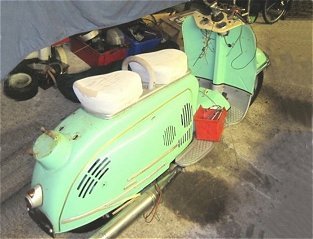 |
 |
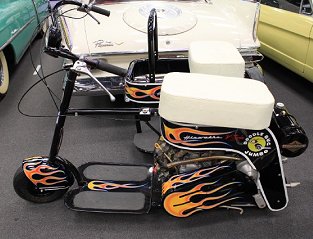 |
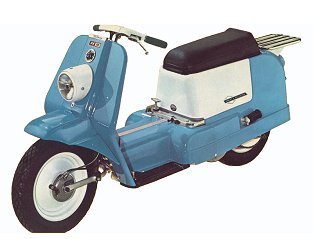 |
|
IWL SR59 Berlin 1960
|
CENTAUR Fold Up Motor
Scooter
|
1960 Beam 'Jumbo Doodlebug'
|
Harley-Davidson 'Topper'
|
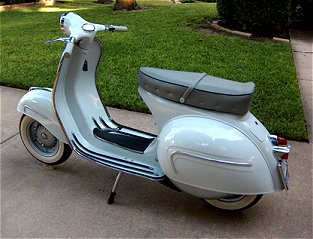 |
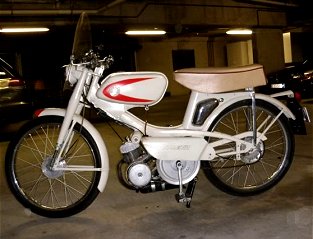 |
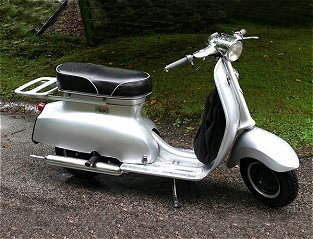 |
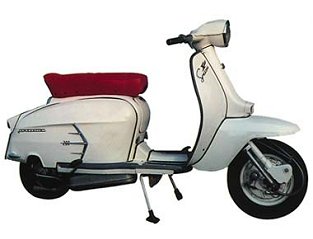 |
|
Vespa 160 GS, 1962
|
Raleigh RM12 Super 50
|
Triumph 'Tina'
|
Lambretta SX200
|
|
|
All
Original Material Copyright SixtiesCity
Other individual owner copyrights may apply to Photographic Images |